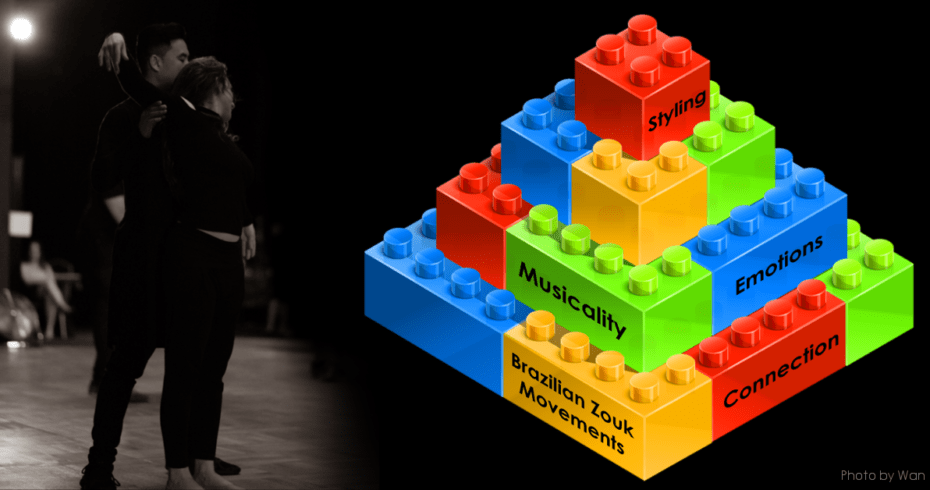Passionate vs mediocre social dancers learn very differently. This blog may give some clues about why you are not improving or help accelerate your learning wherever part of this scale you think are in.
Anamé & I (Hoi) recently taught our concept, ‘The 3 Key Aspects of Social Dance’. During our class, we shared our thoughts about the (1) Physical Aspects which talk about how our body & mind learns movement. We’re not going to be talking about (2) Emotional Aspects or (3) Social Aspects in this blog.
As part of the (1) Physical Aspects, I want to share much deeper thoughts about learning social dance and what I think are the 5 stages we go through in learning each movement. Please note each movement you are learning simultaneously may each be at different learning stages.
This blog isn’t written to prove what is right or wrong on how to learn. This is only my idea and concept of how I think it works at a very high-level overview. You may even come up with your own ideas based on your own experience and expertise.
For clarity, in this blog, we’re not going to go all scientific and debate how the brain & spine build, retain, connect, recall memory, movement responses, elasticity, bandwidth, etc. (That’s beyond some of my current understanding and expertise). I do however have a personal passion for reading and studying about learning, memory retention, mindset, and could still waffle on for a long time about these things!
So here it is, the 5 Stages of Learning Social Dance Movements:
- Copying Movements (Visual)
- Understanding Techniques & Knowledge
- Integration
- Body Awareness & Full Control
- Manifestation & Embodiment
I’ll explain later in much more detail for each of the 5 learning stages.
The reason why I’ve sequentially ordered them like this was that learning stages can be danced even without progressing to the stages below them. If you find yourself struggling to progress at any particular stage, it’s possibly because you’ve not completed the stages above them and trying to skip learning stages.
The further down into the learning stages, you will obtain far safer and more pleasurable dances! It’s down to how much passion, time and willingness you want to invest.
I invest a big portion of my time and money in dance, and know many other passionate dancers who do the same too! This investment is for me, and me alone, if you aren’t willing to invest in yourself, then who will? Some of us work hard to earn money so we can have the financial freedom to do what we love. Dance is what we love so we spend our money on it! If you want a rough figure of how much I’ve spent, to put it in context, much more than my undergraduate degree! These included costs for flights, accommodation, event passes, meals, and private classes.
We must be crazy right?! Why would you want to invest so much money learning social dance? Everyone has their own reason and it’s okay if it isn’t the same as yours.
I’m going to go a little off-topic first to give you some context about what motivates me to keep learning Brazilian Zouk. It is very important to understand what really drives you because Motivation is the key to learning.
For me, it was a curiosity, ever since I experienced a Brazilian Zouk dance that took me out of this world, that bliss of masculine and feminine energy flowing and intertwining during the dance. I went on a pursuit to learn how to recreate this out-of-the-world experience. Though I do enjoy dancing both roles, it’s very different energy attraction with the opposite sex. I guess that’s to do with my biology! 😉
Brazilian Zouk gives me the greatest pleasure in connecting deeply with another person without the need for words. It’s the most truthful and naked conversation with no façade because the body never lies. 🙂 It’s so surreal when another person speaks back the same dance language, once we’ve found each other, that’s when very long interesting conversations happen! This doesn’t happen all the time, still very rare actually, but I learned not to chase it. I focus on myself to keep growing in preparation for the next discovery which keeps getting more and more surreal experience. 😀
Exploring dance gave me a purpose in traveling around the world to discover new dancers while nurturing and developing my dance. I learned so much about myself through traveling; my wants, my needs, my desires, my truth, it’s the most incredible way for self-development. It challenged my weaknesses, my egos, and to overcome them.
I had to open my mind and embrace the learning of all dance disciplines, concepts, and philosophy from everyone. Even from dancers or teachers who I would usually disagree with. There is always something to learn. Studying & reading help open my mind, and the actions of my studies are what produces the results.
My biggest growth is usually when I go out into the unknown and alone. Traveling alone was my biggest fear. Not anymore, I love it! It puts me in situations where I have to make new friends, there is no comfort zone to fall back on, only fear to face. When I look at fear now, it’s a feeling that tells me I have to do it, not the blocker, but the inviter.
Things had never been clearer in life, I am fulfilled, I know what I want.
Passion is your fuel, and a strong open mindset will allow you to overcome obstacles and challenges in the most effective manner. This is very important because a strong open mindset is something that will develop along the way on your dance journey. However, if you don’t have that burning desire, you will NOT progress very far and not get the results you wish for.
How do I know if it’s a burning desire?
Oh, you will know… when it’s constantly in your head every chance it has, it feels it like a thirst, when you start spending a large budget of your money and time on it. You’ll come back from a festival, congress or dance camp and are already looking for your next destination! You will find every opportunity to learn or practice whether at random locations or in your head. You will never get bored and search the internet to read blogs like this to expand your knowledge!
Boredom kills your learning. If you do get bored, then I’m sorry to disappoint you, you will struggle to make progress and hit an early plateau. You feel bored because you don’t have that burning desire yet because it’s just a passing entertainment, a hobby to kill time, that’s not passion. Real passion is when we make time for it and it becomes a part of our lives. Passionate dancers will always have a thirst for knowledge, hunger to understand the details and know more. You can’t force passion and you absolutely cannot create it. Passion is the creator of great things, not the created. It’s for you to find it. There are many ways to find it, my personal suggestion is for you to travel. I’ll write more about this in another blog.
Okay, it’s time for the juicy bit which you’ve all been waiting for. Now for me to explain each of these stages in more detail and how you progress through the chain of learning social dance movements.
Stage 1 – Copying Movements (Visual)
The first and most simple way of learning. We usually tend to use visuals to try and mimic the movements. In class, we get taught the Zouk movements because we need some sort of reference to start learning from. We want to see the end results in its visual form of what we’re trying to achieve.
Some dancers can get stuck in stage 1 where all they do is copy moves and patterns with little or no technique. This is very bad and what is known as rough or forceful dancers. The onus is down to the teachers to teach early on in order to prevent them. Rough, forceful and dangerous dancers should never be the norm in any dance community, and should not be accepted for whatever reason or excuse.
I heard and seen a lot of bullshit over the years that it’s okay as long as it’s fun then people can socially dance for whatever their reasons. I still strongly disagree, especially when it comes to Brazilian Zouk, one of the most technical and dangerous social dances in the world due to the off-axis 3D movements. There isn’t enough health research and data yet because it’s such a young developing dance, give it another few decades, there could be a lot of back problems. I’m not trying to deter or put you off from learning. For longevity, learn it correctly.
We can still avoid this potential problem if safety and proper techniques are taught at the right time when students actually have real dance foundation laid out. Not monkey see monkey do after only a few months or a year of copying movements.
Generally, I have a high tolerance for many things I’ve seen and experienced and find humor in practically nearly anything. However, when it comes to safety, I have zero tolerance or patience for negligence and ignorance that endanger others. Endangering your own safety is your choice, but in social dance, you are given the responsibility of another person’s safety. Seriously, think and be considerate. (This isn’t referring to just the men, I’m referring to rough, dangerous and forceful ladies too. Please respect each other’s body, the guy’s body is also his temple!)
Sorry to keep blabbering on about safety because in stage 1 of learning is where most of the problems arise. Safety is priority #1 and needs to sink into all our heads and be repeated again and again. Over 4 years ago, I’ve personally suffered 2 back injuries from rough, forceful and dangerous dancers, my health can’t be substituted. It was a terrifying past experience and was an identified problem in the city in which the teachers have been working hard over the years to overcome and things have improved.
Stage 2 – Understanding Techniques & Knowledge
Once we’ve copied the moves or have an idea of what it looks like, we start to try to understand it, what we are doing and why we are doing it. We start to learn about techniques, how and why we apply them to a movement. Different techniques each have different purposes; it could be to make the movement smoother, manipulating flow, created elasticity, increase comfort for you and your partner, improve connection (physically or emotionally), controlling pressure or tension, used for preparation, it may help even help with styling, etc.
You can certainly improve this area by taking courses or programmes that focus on particular techniques or private classes that have deeper explanations. If you are the type who gets bored listening, then you won’t progress in this area at all. You need to listen and listen carefully because it’s all in the detail.
Reading will help improve your knowledge and understanding. There are a number of blog writers who I really respect their views and vast experience. You can find links to their blog sites listed on my zouk-cheat-sheet. Don’t forget to also browse my other blog posts on this website!
Some dancers may talk the talk, but not walk the walk. Having an abundance of knowledge and understanding techniques are useful, but useless at the same time if you don’t teach your body how to apply them in real-time. The worst are the ones spouting theory trying to teach others during socials when they are incapable of executing it themselves. Keep reading…
Stage 3 – Integration
This is where most dancers will spend their time training in classes, workshops and practice times. It will be filled with frustration. This is the stage where you will explore through trial and error. You should be using different feedback cues to work out what you need to change in order to execute the movements with techniques correctly.
Some dancers will spend a long long long long long long time here and it’s mostly due to trying to learn too many moves, patterns, and even too many techniques at once.
To put it simply, every movement and every technique you learn, you need to integrate them together and even figure out the combinations of what can be applied together. It’s like chemistry with different mixtures.
This is the stage where it’s also easy to accidentally (intentionally or unintentionally) turn our movements into automation mode. There has always been a misconception for beginners that dance is automated; teaching your body to do something without thinking so they can focus on the music or focus on feeling the lead or follow. This is not true. You should always be conscious of everything you are doing at all times.
When training in this stage, you should focus on blending only a few movements and techniques together. You want to work out the possible changes and try to understand their effects. If you train by repeating and doing exactly the same thing over and over again, this is heading towards automation mode.
It’s very possible to still dance well and be a good social dancer staying at this stage and not progress beyond. Many social dancers are happy to stay within the first 3 stages.
Stage 4 – Body Awareness & Full Control
The most difficult and challenging of all the learning stages. Most of us won’t reach this stage until after fully developing a number of basic Brazilian Zouk movements and techniques. It’s going to be constant inner battles if you ever reach this stage 4. This involves honing your body sensitivity & inner communication; constant re-evaluation of posture and tensions on every inch of our bodies.
We start to learn more about listening to our own bodies, using just enough and relaxing any parts that aren’t required. Turn off all noises in your head, turn off all noises from your body (unnecessary movements), again becoming more efficient with less wastage. You learn to feel and move any single part of your body and understand how it can affect tensions on other parts. The control of stillness is an exceptional ability.
Full control does not mean taking control of the dance like a dictator. Do you have the control to let go and not fight the flow? Do you have control to let go of tension? Do you have the control to move at will?
There are many ways to work on this including meditation, breathing exercises, practicing silence while turning down the volume of your own body and block out all noise outside. It’s practicing to focus on listening when you make a change, can you feel the rippling effects it has on your body?
As you improve in stage 4, you will find learning new movements through stages 1-3 should also improve at an accelerated rate. This is why those who have excelled in other disciplines are able to learn new disciplines much quicker.
Stage 5 – Manifestation & Embodiment
It’s time to pull together everything from the stages you’ve learned for each movement. This stage 5 is learning to manifest complexity into simplicity through our bodies. Imagine the time when you watch pros dance socially and how they made everything look so simple yet complex layers are there yet invisible to most.
You may use concepts to help manifest your dance movements. For example, I like using the concept of social dance is a language.
The communication of talking and listening to each other without the need for words. I would suggest movements to the ladies, she would consider her options and decide what she would like to do. She communicates back what she is doing. I listen and follow her choice of movement until she’s finished and waiting to listen for my next suggestion. Adding musicality, the entire dance now becomes a conversation telling the story of the song.
If you’ve ever reached this stage 5, I would say you’ve embodied what social dancing experience is truly about. Being able to manifest complexity into simplicity through our bodies.
To truly reach embodiment, it means to be full-body, you would have FELT experience of that thing/state/experience. It means that you don’t just know something as thoughts or mental understanding, but also feel it as it occurs within the sensations of your body.
Now just because you’ve reached this stage 5 for learning some movements doesn’t mean the learning ends here. You’ll go back again to stage 1 and repeat the cycle! Yay to learning, it never ends unless you choose to! Your body will absorb and learn a much faster rate if you’ve reached this stage 5 even once. It will accelerate even faster as you cycle these stages multiple times as you continue to grow and master your repertoire.
Don’t be so disappointed if you have to break your dance. I broke my dance multiple times, maybe too many times than I would have liked! I know for a fact I will continue breaking it in the future. Breaking your dance is a good thing, it’s not bad. It’s a chance to start again. You’ll get better at putting your dance together again, this is a really useful skill for adapting to the social dance.
Recently, Anderson & Brenda broke it so bad I didn’t know how to dance anymore. That included being unable to do even the simplest basic steps. It took a few weeks to pick up the good pieces and start again but now it’s built much more solid foundation thanks to it! 😀
Think of it as rebirth, like how a Phoenix rises from the ashes again and comes back stronger each time!
Brazilian Zouk will continuously evolve and will always have plenty of new stuff to learn and develop. Maybe you can take up a different dance and try integrating that into Brazilian Zouk!
Bonus – The Building Blocks of Social Dance
If you’ve read this far, well done! 🙂
Musicality, Connection, Emotions, Styling are the other building blocks that build your social dance together with the Brazilian Zouk Movements. However, I won’t be going into detail about learning them in this blog.
At some point in your dance journey learning Brazilian Zouk, you should have felt a strong connection with particular partners during social dancing. You will hunger for it and chasing to learn to better your ‘Connection’.
Some people (“not dancers”) may even skip the entire Brazilian Zouk Movement building block (1-5 learning stages) and focus just on ‘Connection’. These are your huggers on the social dance floor, they aren’t there to dance! Don’t be a hugger, be a social dancer and learn to move! 😛
To become a great social dancer you need to be well-rounded and need to also work on improving all the other building blocks too. For me personally, I’ve always prioritised Styling at the very bottom. I’m probably the ugliest looking dancer (I’ve seen my videos)!
To summarise, I’ve created some illustrations to help you digest some of the information
Please note there may be other building blocks and I’ve only included the most common ones I could think of at the time of writing this.
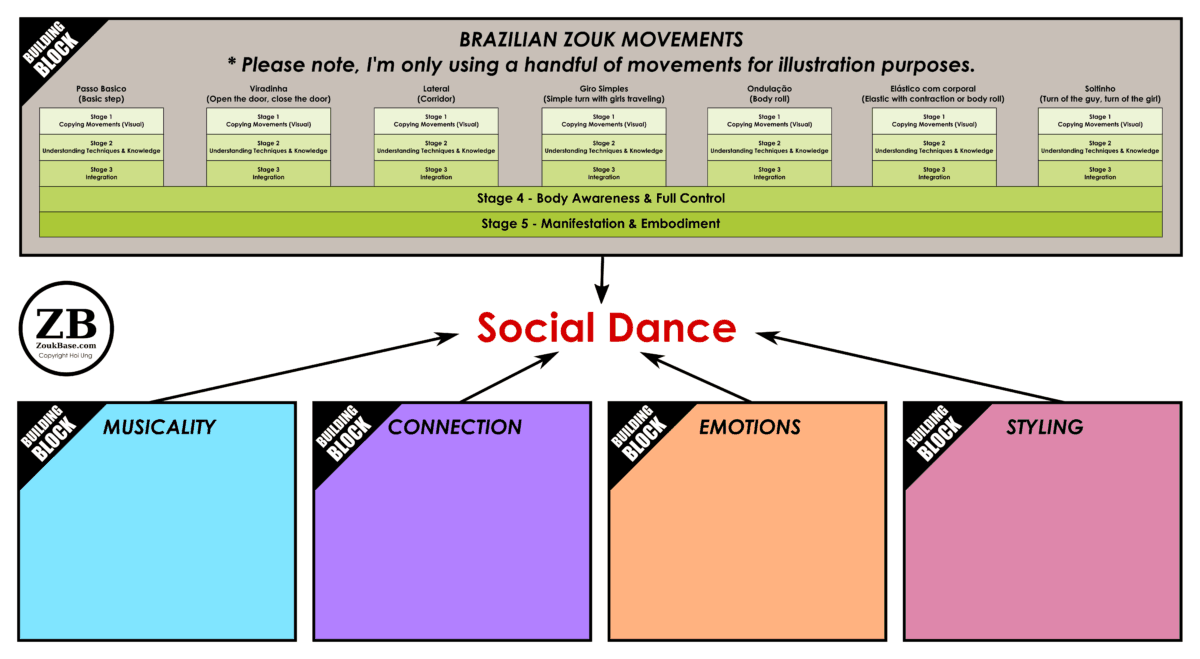
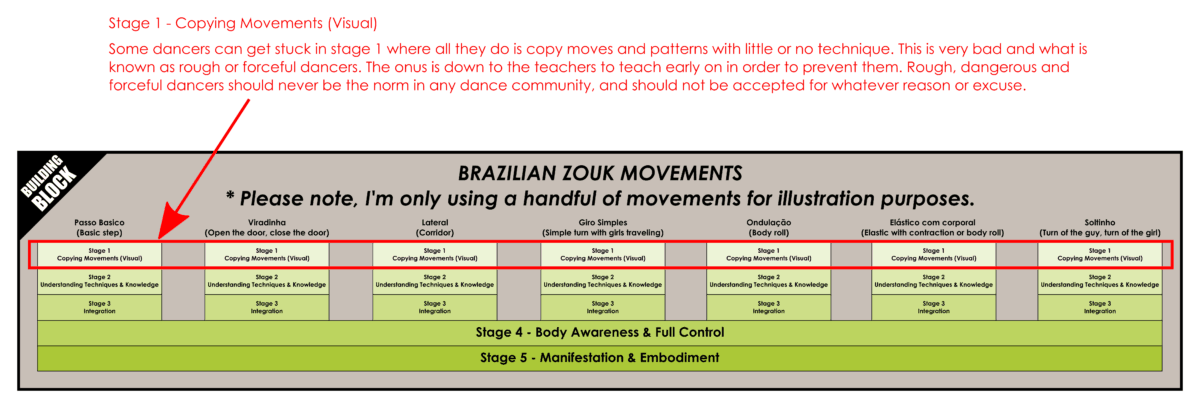
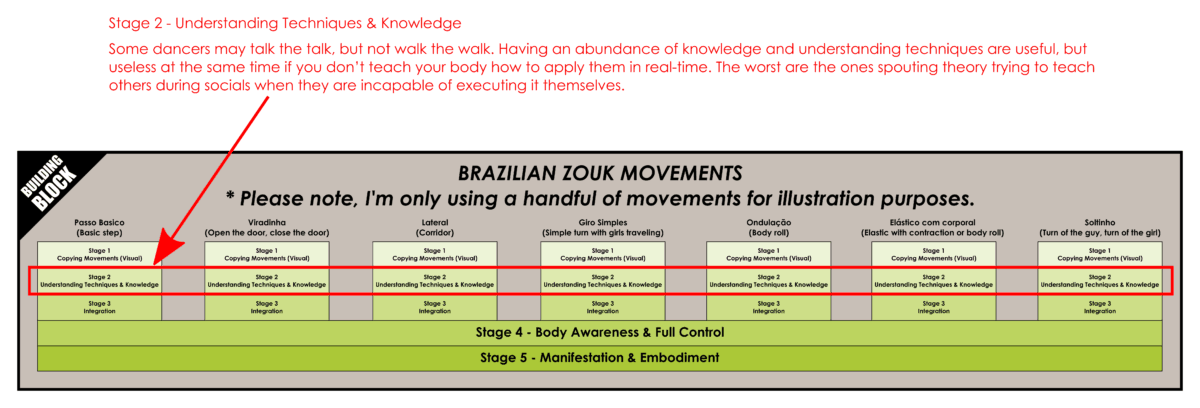
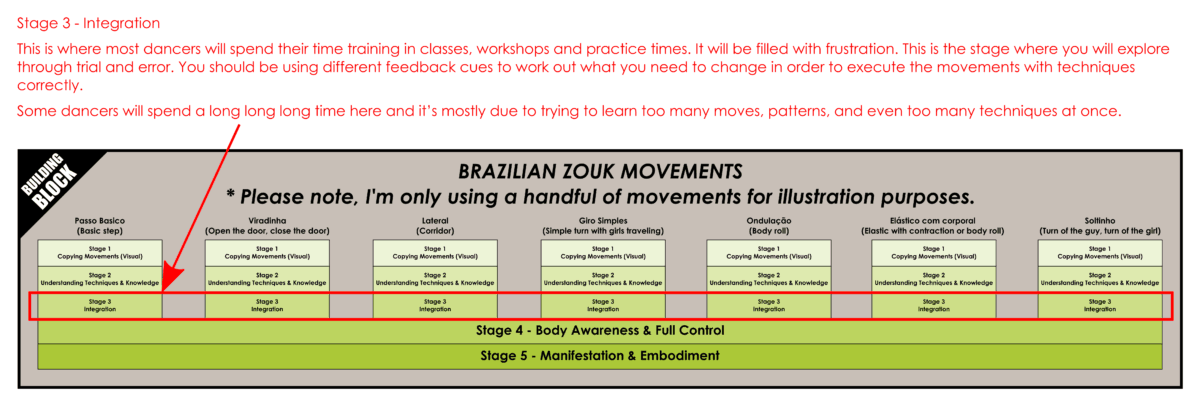
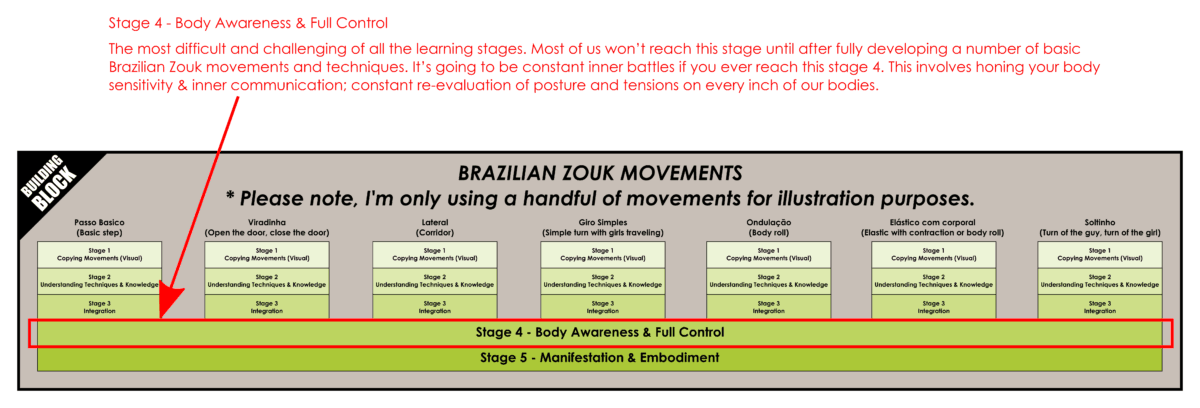
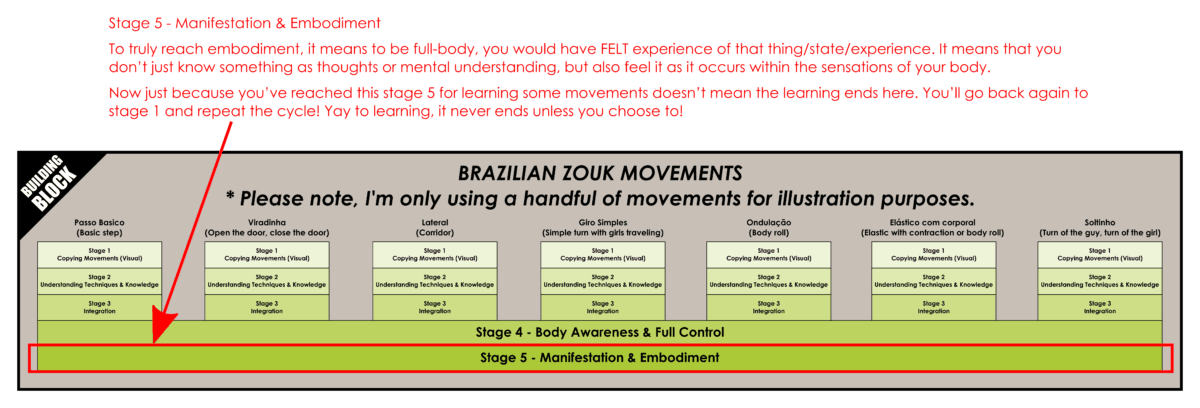
Thanks again for reading my blog and I hope you’ve enjoyed my views. If you found this useful, please help share so others can benefit too!
Hoi x

